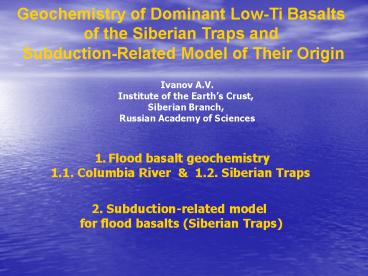Geochemistry of Dominant Low-Ti Basalts - PowerPoint PPT Presentation
1 / 23
Title:
Geochemistry of Dominant Low-Ti Basalts
Description:
Geochemistry of Dominant Low-Ti Basalts. of the Siberian Traps and. Subduction-Related Model of Their Origin. Flood basalt geochemistry. 1.1. Columbia River & 1.2. ... – PowerPoint PPT presentation
Number of Views:130
Avg rating:3.0/5.0
Title: Geochemistry of Dominant Low-Ti Basalts
1
Geochemistry of Dominant Low-Ti Basalts of the
Siberian Traps and Subduction-Related Model of
Their Origin
Ivanov A.V. Institute of the Earths Crust,
Siberian Branch, Russian Academy of Sciences
- Flood basalt geochemistry
- 1.1. Columbia River 1.2. Siberian Traps
2. Subduction-related model for flood basalts
(Siberian Traps)
2
Columbia river
Os-isotope data are after Chesley and Ruiz (1998)
3
Columbia river
Data are plotted after Hooper and Hawkesworth
(1993)
4
Columbia river
Data are plotted after Hooper and Hawkesworth
(1993)
5
Columbia river
6
Columbia river
High-Mg basalts of Klyuchevskoi volcano
7
Siberian Traps
Pangea
8
Siberian Traps
Ages are for basalts only !
9
Siberian Traps
Approximate size of the Columbia River flood
basalts
10
Siberian Traps
Norilsk
11
Siberian Traps
Upper Morongovsky subsuite to Samoedsky suite
basalts are not contaminated
Saddle Mountains
Imnaha
Data are plotted after Wooden et al. (1993)
12
Siberian Traps
Data are plotted after Wooden et al. (1993)
13
Siberian Traps
14
Siberian Traps
15
Siberian Traps
Subduction signatures are more prominent
16
Model
After Ohtani (2005)
17
Model
Based on Bina et al. (2001), Litasov and Ohtani
(2003), Hirschmann et al. (2005)
18
Siberian Traps
2300 km
Transbaikalian belt (Andean-type orogen)
19
Model
Transbaikalian belt
20
Model
Siberian Traps, Norilsk event
21
Model
Siberian Traps, Tunguska event
22
Conclusions
1. Primitive mantle-derived flood basalts (with
Siberian Traps and Columbia River as examples)
show similarities with typical island-arc
basalts. They are remarkably different with ocean
island basalts. 2. Flood basalt origin can be
explained by water-recycling through transition
zone of mantle via stagnated (by depth)
subduction.
23
Thanks!































